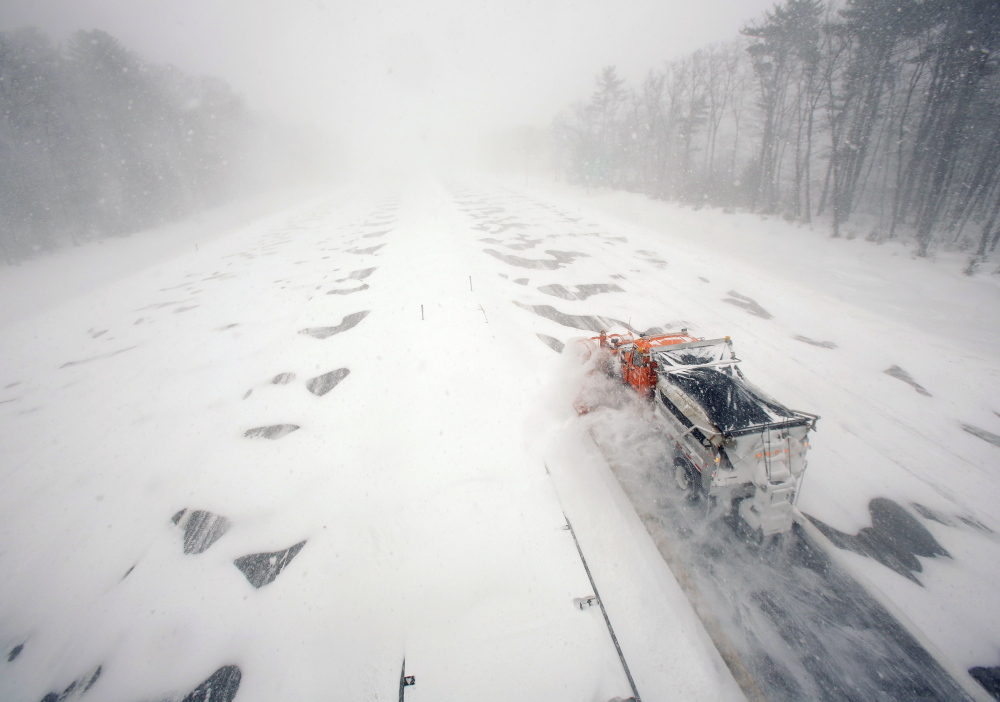The recent string of snowstorms in Maine has taken a big chunk out of the maintenance budgets of the agencies that run the state’s highways, but officials say they plan for winters like this and aren’t worried just yet.
For the Maine Turnpike Authority, the drop-off in traffic (and tolls) during a storm hurt the bottom line even more than the expense of clearing snow on the 109-mile highway. Surprisingly, revenue losses may be even greater during bad weather in the summer when the authority makes most of its money from tourists coming to Maine.
“A bad rainy weekend in June costs as much or more than a blizzard would cost in February,” said Doug Davidson, the authority’s chief financial officer.
Meanwhile, the Maine Department of Transportation has spent $20.5 million so far this winter clearing snow and melting ice on the state’s 8,200 miles of highways. That’s slightly ahead of the $19.3 million the department had spent at this point last year, which was an average year for snowfall as measured by National Weather Service office in Gray.
Last year was more costly than average, however, because there was lot of ice that had to be treated with salt. The state used more than 90,000 tons of salt last winter, compared with the 88,500 tons it has used so far this year.
Ice is not the problem this winter. It’s the huge volume of snow that has to be pushed off the travel lanes, said Ted Talbot, spokesman for the department.
“This year, you don’t have to pretreat the roads as much,” he said, citing the lack of icing. “It’s just plowing snow.”
So far this winter, Gray has received 84.8 inches of snow – an inch more than the normal snowfall for an entire Maine winter. Some parts of the state have seen even more. The depth of the snowpack at the Bangor International Airport on Wednesday morning was 53 inches – tying the all-time record for Bangor that was previously set in 1969.
The “double whammy” of decreased tolls and increased operating expenses hit the turnpike especially hard during the blizzard on Jan. 27, said the authority’s executive director, Peter Mills.
For example, he said, a toll worker at the Portland International Jetport exit collected only four tolls during a four-hour period on the day of the storm. The storm cost the authority an estimated $310,000 in lost revenue. To clear the roads, the authority spent $81,600 on overtime wages, $81,500 for salt and $11,000 for fuel.
The authority’s winter maintenance assumes there will be 14 snow events every winter, based on a rolling 10-year average. This season there have been nine such events, said Davidson, the authority’s finance person. And there’s still plenty of winter of left, he said. In Maine, snow can fall from October through April.
One unexpected problem: The turnpike’s median is narrower than those of most highways in the federal interstate system, which means it’s running out of space to pile snow.
Mills said the maintenance budget for the authority is predictable – it budgets about $10 million a year for highway and equipment maintenance, of which roughly a third is spent for winter maintenance.
“We plan for winters like this,” he said.
The greater concern is volatility of revenue, especially in the summer, he said.
The Department of Transportation doesn’t have a separate snow removal budget. Rather, it has $284 million to spend on maintenance during the two years covered by the state’s biennial budget. So if the state spends a lot of money on highway maintenance in the winter, it can cut back on maintenance during the summer months, such as tree trimming and replacing signs, Talbot said.
“We do what we need to do for the wintertime,” he said. “We have to keep the roads clear and keep it safe. In April, we look to see where we are at.”
Send questions/comments to the editors.



Success. Please wait for the page to reload. If the page does not reload within 5 seconds, please refresh the page.
Enter your email and password to access comments.
Hi, to comment on stories you must . This profile is in addition to your subscription and website login.
Already have a commenting profile? .
Invalid username/password.
Please check your email to confirm and complete your registration.
Only subscribers are eligible to post comments. Please subscribe or login first for digital access. Here’s why.
Use the form below to reset your password. When you've submitted your account email, we will send an email with a reset code.